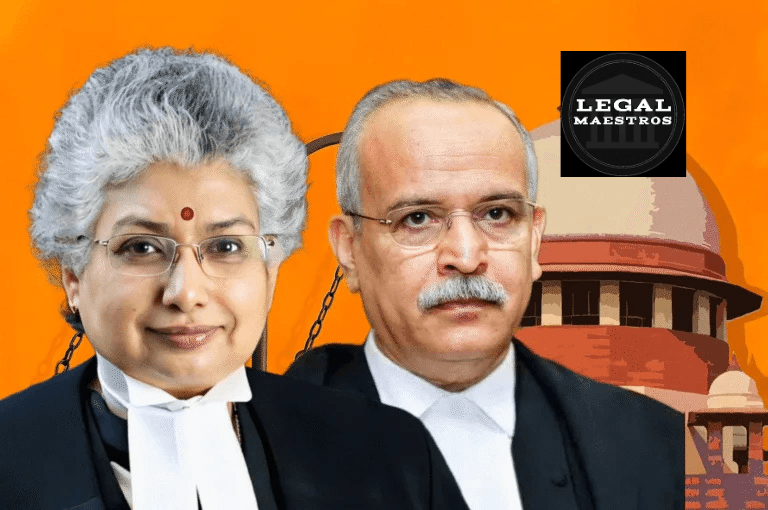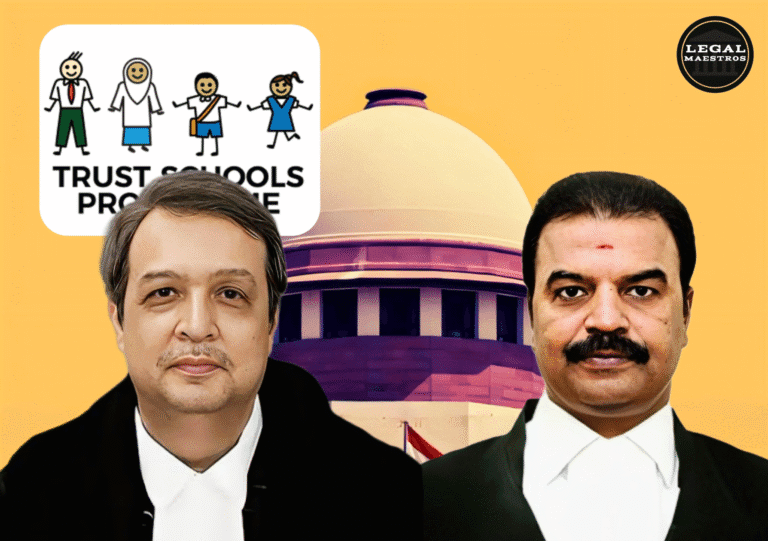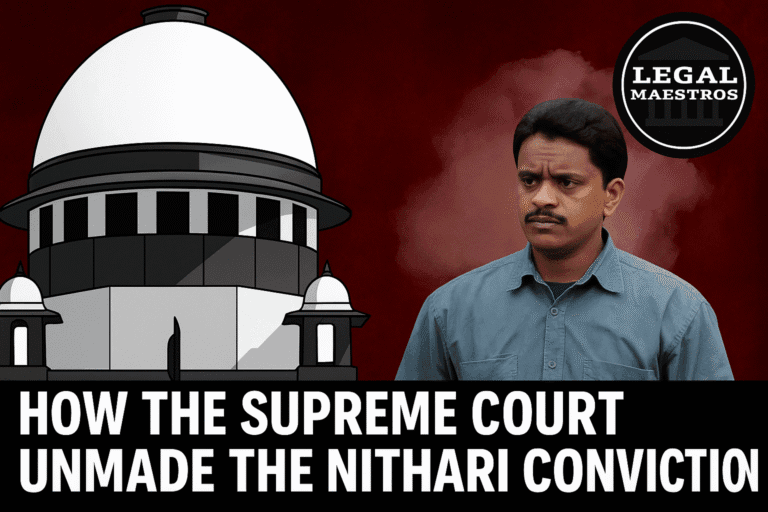
Can Passing Of Any Law By Parliament Or State Legislature Be Held To Be Contempt Of Court?
Introduction
The way the Supreme Court dealt with the writ petitions filed by Nandini Sundar and the contempt measures that went along with them shows how delicate the balance is between judicial authority, legislative power, and human rights.
These petitions, which are at the heart of the debate, are about sending Special Police Officers (SPOs) and extra soldiers to the areas of Chhattisgarh that are now facing unrest.
For any queries or to publish an article or post or advertisement on our platform, do call at +91 6377460764 or email us at contact@legalmaestros.com.
The Supreme Court dealt with basic issues like administrative overreach, helping victims get back on their feet, and the separation of powers by giving clear orders and looking into any infractions. The Supreme Court has shown its commitment to following the law by ending these long-running disputes without going beyond its duties to interpret the law.
Facts of the Case
At the beginning of 2007, public interest litigants led by Dr. Nandini Sundar filed a petition with the Supreme Court. The petition brought up problems with the Salwa Judum movement working with government officials and with getting civilians to work as SPOs.
It is thought that both Maoist groups and armed civilians have been involved in a number of violent crimes in Dantewada and the areas around it. Rape, abduction, arson, and murder are some of these crimes.
For any queries or to publish an article or post or advertisement on our platform, do call at +91 6377460764 or email us at contact@legalmaestros.com.
In March 2011, the Court wrote down specific examples of violence against Swami Agnivesh, a human rights activist, as well as occurrences that happened in areas like Morapalli and Tadmetla. At the same time, a fire at Justice Varma’s official apartment revealed sacks of burned money. This led to questions about how the SPO was funded and whether the state was involved.
For More Updates & Regular notes, Join Our WhatsApp group (https://chat.whatsapp.com/DkucckgAEJbCtXwXr2yIt0) and Telegram Group ( https://t.me/legalmaestroeducators )
High Court Directions and Inquiry
For any queries or to publish an article or post or advertisement on our platform, do call at +91 6377460764 or email us at contact@legalmaestros.com.
The Supreme Court used its constitutional writ power to make rulings on July 5, 2011, that were seen as important. The State of Chhattisgarh was told to stop using Specialized Police Officers (SPOs) for counter-insurgency right away, to get back any weapons that were supplied to them, and to protect former SPOs from any reprisal.
The court also told the police to look into how Salwa Judum and Koya Commando worked and said that private armed groups could not be formed.
The Central Bureau of Investigation was supposed to look into some violent events and give a preliminary report within six weeks by using simultaneous orders. The state and federal governments also have to send in compliance reports.
For any queries or to publish an article or post or advertisement on our platform, do call at +91 6377460764 or email us at contact@legalmaestros.com.
Formation of Inquiry Committee and Its Findings
Because of the Court’s orders, an inquiry framework was set up to find out what happened and hold people accountable. The police department’s records were looked at, witnesses were questioned, and the committee checked to see if the state was following the rules.
The committee discovered proof of recurring human rights violations, but it also showed that the state couldn’t help victims get better or punish those who were involved.
For any queries or to publish an article or post or advertisement on our platform, do call at +91 6377460764 or email us at contact@legalmaestros.com.
The petitioners said that new laws that formalized auxiliary soldiers had weakened the Court’s decisions, and the committee’s detailed status report was used as the foundation for the contempt allegations.
Legal Framework and Provisions at Issue
The argument was mostly on the Judiciary’s ability to issue writs and carry out its orders, as stated in Articles 32 and 142 of the Constitution. Articles 245 and 246 talk about how the legislative branch is more important than this power.
For any queries or to publish an article or post or advertisement on our platform, do call at +91 6377460764 or email us at contact@legalmaestros.com.
The petitioners relied on the Court’s inherent jurisdiction to defend basic rights and force the government to take action. In 2011, the state of Chhattisgarh approved the Chhattisgarh Auxiliary Armed Police Force Act.
The state said it was within its full legislative jurisdiction to set up local security systems. Because of this disagreement, issues about the limits of judicial intervention in policy matters and the scope of contempt jurisdiction became more important.
Conflict Between Legislation and Judicial Orders
Petitioners said that the new Act went against what the Supreme Court said in July 2011 since it allowed armed civilian groups that were similar to SPOs to operate again. They filed the petitions for contempt in order to make the legislation unconstitutional and force the implementation of rehabilitation programs that had been approved by the court.
For any queries or to publish an article or post or advertisement on our platform, do call at +91 6377460764 or email us at contact@legalmaestros.com.
The state made a counterargument, saying that lawmakers can establish laws until the courts expressly strike them down, and that just making a bill couldn’t be seen as contempt. The Supreme Court looked at the pleas and established a distinction between questioning the constitutionality of a law and expressing contempt for not following court orders.
- The Petition for Contempt of Court and How It Was Resolved
The Supreme Court made it clear in its ruling on May 15, 2025, that a law is lawful until it is found to be unconstitutional. The court thus did not see the passing of the law as contempt. - The Court said that anyone who say they are not following its orders need not go through contempt procedures but should instead contest the constitutionality of the Act.
- It noted that the orders from 2011 had satisfactorily dealt with the petitions that were already there and that the CBI had provided compliance reports and investigations. Because of this, the petitions for writ and contempt were thrown out, and the applications that were still pending were closed as spent.
Contempt Petition and Its Resolution
The Constitution’s principle of separation of powers is shown by the fact that the Supreme Court won’t say that legislative action is the same as contempt because of the Constitution. Judicial review protects citizens from unconstitutional laws, but it does not protect them from laws that were passed by a majority of voters.
This is only possible through the employment of contempt jurisdiction. The Supreme Court has said again that legislative bodies can make and change laws as long as they follow the rules set out in the Constitution. In this scenario, the judges’ restraint helps maintain the institution’s integrity and stops them from getting in the way of adopting policies.
For any queries or to publish an article or post or advertisement on our platform, do call at +91 6377460764 or email us at contact@legalmaestros.com.
Constitutional Principles and Human Rights Concerns
Even while it supported the primacy of the legislature, the Supreme Court also reaffirmed the state’s duty to protect life and personal freedom, as stated in Article 21. This duty includes steps to help victims get well and keep former Special Protection Officers safe.
It stressed that the Union and state governments have ongoing responsibilities to work together to keep the peace and uphold basic rights. The Court’s decisions had already put in place processes for paying people back, looking into past violations, and protecting communities that were affected. This shows how the Court helps to guide remedial action within the limits of the Constitution.
Conclusions and Implications
The case of Nandini Sundar shows how the courts have two jobs: to actively protect basic rights through orders and investigations, and to recognize the legislative competence in the process of establishing laws.
For any queries or to publish an article or post or advertisement on our platform, do call at +91 6377460764 or email us at contact@legalmaestros.com.
The Supreme Court found a middle ground between responsibility and respect for institutions by throwing out the petitions after the basic commands had been followed and explaining the right ways to dispute laws.
In the future, anyone who wish to challenge laws will have to go through constitutional validity proceedings instead of contempt cases. This decision not only sets a precedent for how to separate judicial and legislative realms, but it also strengthens the idea that both courts and lawmakers need to be careful to preserve the rule of law.






![Research Assistantship @ Sahibnoor Singh Sindhu, [Remote; Stipend of Rs. 7.5k; Dec 2025 & Jan 2026]: Apply by Nov 14, 2025!](https://legalmaestros.com/wp-content/uploads/2025/11/Gemini_Generated_Image_s0k4u6s0k4u6s0k4-768x707.png)
![Karanjawala & Co Hiring Freshers for Legal Counsel [Immediate Joining; Full Time Position in Delhi]: Apply Now!](https://legalmaestros.com/wp-content/uploads/2025/11/Gemini_Generated_Image_52f8mg52f8mg52f8-768x711.png)